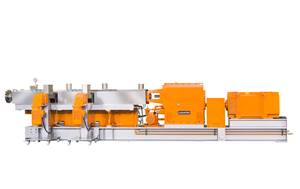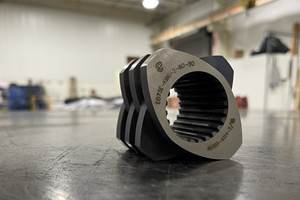'Cleaner,' More Efficient Additives for Flexible and Rigid PVC
New vinyl additives designed to be more environmentally friendly while offering improved performance are available from Crompton Corp., Middlebury, Conn.
New vinyl additives designed to be more environmentally friendly while offering improved performance are available from Crompton Corp., Middlebury, Conn. Among the firm’s latest developments are low-VOC heat stabilizers for flexible and rigid PVC and impact modifiers for rigid PVC.
Stabilizers for flexibles
The Mark 9300 Series of CaZn and BaZn liquid heat stabilizers were originally developed for low VOC emissions in general-purpose flexible PVC. They have less than 10 ppm phenol content, and they resist hydrolysis and free-phenol formation, suiting them for low-emission indoor flooring and auto interior uses. More recently, another advantage of these products has become apparent. They also have very low phosphorus content—under 2.5%—compared with 3% to 5% for conventional mixed-metal liquid stabilizers. Higher phosphorus content has been found to be related to problems of exudation and poor printability.
Included in this series are Mark 9306, a low-phosphite CaZn, and Mark 9302, a high-efficiency BaZn. These stabilizers reportedly confer low plate-out, higher resistance to oxidation, good clarity, and better heat stability than conventional mixed-metal liquids. They are also said to provide good printability due to the low plate-out, and finished products survive very well in hot, humid climates and during warehouse storage. These stabilizers are premium priced but they can be used at 20% to 25% lower levels (2 to 3 phr) than conventional stabilizers in many applications.
Crompton is also developing a new tri-metal (CaKZn) liquid. Recommended at 2 to 3 phr use levels, this heat stabilizer has been shown to outperform conventional BaZn stabilizers in clear and filled flexible compounds for uses other than wire and cable. FDA approval for food contact is expected.
Also new is a solid CaZn heat stabilizer, Mark 6796, recommended for wire and cable jacketing, light-duty primary insulation, and general-purpose flexible PVC extrusion. The product is said to halt die-lip drool and is used at 3 to 4 phr as an alternative to lead or Ba/Zn stabilizers.
Another new solid CaZn is Mark 6797 for heavily filled, flame-retardant compounds used in plenum jacketing. The stabilizer reportedly will not add to flammability or smoke generation, unlike many other stabilizers. Typical use levels are 2.5 to 8.0 phr.
Mark 6784 ACM is a new solid CaZn for primary building-wire insulation. It’s reportedly the first alternative that meets UL83 standards, both wet and dry. Typical use level is approximately 4 to 6 phr.
Mark 6790 is a solid CaZn stabilizer for automotive interiors, where there is a trend to replace BaZn heat stabilizers in flexible applications such as door and instrument panels. Used at 2 to 3 phr, the product boasts very low fogging.
Stabilizers for rigids
Low-volatility heat stabilizers for rigid PVC also number among Crompton’s new offerings. One example is Mark 3166, a liquid methyltin for rigid calendering and profile extrusion. It boasts very low odor and is recommended at 1.20 to 1.50 phr.
Mark 2915 is a new liquid butyltin stabilizer for rigid foam profiles and sheet. It is said to act both as a stabilizer and an activator for azodicarbonamide foaming agents. It reportedly provides 10% lower foam density than standard tin mercaptides and is self-lubricating, which is said to produce surface smoothness and less pinking. Use level is typically 2.5 phr.
Also new is Mark 2914 butyl-based tin stabilizer for fencing and window profiles. It offers improved flow, allowing for higher output rates. This product was developed to minimize plate-out and chatter in the calibrator at high line speeds. It is said to provide excellent long-term heat stability. Use levels are 1 to 1.5 phr.
Crompton has a new liquid methyltin one-pack stabilizer/lubricant package for NSF- and PPI-approved PVC pipe. Mark 2910 is said to be the first self-lubricating (paraffinic) methyltin on the market. It eliminates the need for paraffin wax and provides the heat stability required for pipe extrusion. At use levels of 2.0 to 2.3 phr, this additive has been shown to greatly reduce plate-out and to allow for a higher flow rate from the die.
Crompton is also developing CaZn stabilizers that can offer improved weatherability of white window and fencing profiles in hot, arid climates. One example is TS 1206, a solid CaZn one-pack with internal and external lubricants, recommended for use at 4 phr. It is said to help prevent surface degradation and yellowing due to uv, heat, and dryness. Crompton will develop a series of these products to match user needs in terms of color development and long-term heat stability.
Modifiers for rigids
Since its 2003 acquisition of GE Specialty Chemicals, Crompton has further expanded the Blendex line of impact modifiers for PVC. New for rigids is Blendex 338, an ABS impact modifier designed for the non-weatherable substrate layer of siding and fencing. According to Crompton, it acts as a fusion promoter, so that it can be used at lower levels than acrylic impact modifiers—2 to 3 phr vs. 4 phr, with no processing aid added. In addition to lower concentrations, this modifier allows for higher filler levels, which permit further cost savings.
Related Content
Equipment for Compounding, Reactive Extrusion, Devolatilization, Foaming and Direct Extrusion
NPE2024: Leistritz to focus on advances made via twin-screw extrusion.
Read MoreUnderstanding 'Boundary Conditions' in Twin-Screw Compounding
In twin-screw compounding, the objective is generally to produce the highest quality product at the maximum strand. But sometimes there are operating parameters that prevent this objective from being realized.
Read MoreHow to Configure Your Twin-Screw Extruder for Mixing: Part 5
Understand the differences between distributive and dispersive mixing, and how you can promote one or the other in your screw design.
Read MoreProgram Helps Compounders Configure Screw, Barrel Layout
New software from ENTEK is said to make it easier for compounders to design their own screw and barrel configurations.
Read MoreRead Next
See Recyclers Close the Loop on Trade Show Production Scrap at NPE2024
A collaboration between show organizer PLASTICS, recycler CPR and size reduction experts WEIMA and Conair recovered and recycled all production scrap at NPE2024.
Read MoreMaking the Circular Economy a Reality
Driven by brand owner demands and new worldwide legislation, the entire supply chain is working toward the shift to circularity, with some evidence the circular economy has already begun.
Read MoreLead the Conversation, Change the Conversation
Coverage of single-use plastics can be both misleading and demoralizing. Here are 10 tips for changing the perception of the plastics industry at your company and in your community.
Read More













